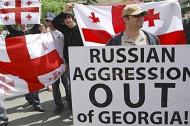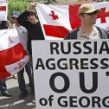
ANNEXATION AND MILITARIZATION OF ABKHAZIA CONTINUE APACE
Publication: Eurasia Daily Monitor Volume: 5 Issue: 83
By:

Russia has again challenged Georgia and the West in Abkhazia, this time with military action. Its first challenge had been President Vladimir Putin’s April 16 decree, authorizing direct official relations between Russian government bodies and the secessionist authorities in Georgia’s Abkhazia and South Ossetia regions (see EDM, April 18). This unilateral move amounted to official “legal” recognition in terms of Russian law, formalizing Russia’s de facto annexation policy in the two territories.
This move is now being followed up with overt militarization and cross-border acts of aggression in Abkhazia.
On April 20 a Russian MIG-29 fighter plane shot down a Georgian unmanned aerial reconnaissance vehicle (UAV) over the Gali district in southern Abkhazia, deep inside the internationally recognized Georgian territory and airspace. The Israeli-made, Georgian-operated UAV is an unarmed drone, merely a flying photographic and video camera, used by Georgia ‘s Internal Affairs Ministry to ascertain Russian military movements in Abkhazia. The drone transmitted in real time the images of the Russian plane approaching and firing an air-to-air missile at the UAV. Posted by Georgian authorities on you.tube, the film corroborates Georgian radar data tracking that same MIG-29 as it gained altitude over the Russian-held Gudauta military airfield, flying over the Gali district and then turning north into Russian airspace. Georgia immediately proposed to Russia to exchange radar and any other data on the incident. As of April 30 the Russian side had not responded (Georgian Ministry of Foreign Affairs statements, April 21, 26, 30; Russian Ministry of Foreign Affairs statement, April 29).
Moscow claims that any one of the new NATO member countries with residual MIG inventories might have staged the incident in order to provoke Russia. Minister of Foreign Affairs Sergei Lavrov told this tale to the European Union during high-level meetings on overall EU-Russia relations on April 29 and 30 in Luxemburg (Interfax, April 29, 30). This claim brings a slight variation to the master theme that Georgia fires at Georgian targets in order to accuse Russia, as Moscow insisted after the Russian air attacks in March and August 2007 over Abkhazia and South Ossetia, respectively.
Unwittingly contradicting Moscow‘s version of the April 20 incident, Abkhaz authorities were quick to claim that they had themselves shot down the Georgian UAV (Apsnypress, April 21). Although inherently absurd, this claim could have prompted international inquiries to Russia about its illegal arms deliveries to Abkhaz proxy forces, inside the internationally recognized Georgian territory. Such inquiries have yet to come, however.
By shooting down the UAV, Moscow almost certainly aimed to reduce Georgian (and, by implication, Western) ability to monitor the next Russian military moves into Abkhazia, which have been underway since at least April 29. On that date Russian convoys of artillery, armored vehicles, and additional troop units crossed the internationally recognized Russia-Georgia border at the Psou River, into the secessionist territory. Moscow has announced that its troops opened and are manning a number of new “border checkpoints” on what Moscow described as a Russian-Abkhazian border, which is actually the Russian-Georgian border in international law (Interfax, April 29, 30).
Moscow claims, as Lavrov told the EU in the Luxemburg meeting, to be “preventing bloodshed” and “protecting Russia’s citizens” in Abkhazia, in response to Georgian troop deployments in the upper Kodori Valley. The United Nations Observer Mission in Georgia (UNOMIG), however, indirectly refuted that accusation by announcing that it had not observed any such Georgian troop deployments. UNOMIG monitors the area alongside Russia’s own “peacekeeping” troops. On the whole, Moscow portrays its latest military moves as an increase in its “peacekeeping” operation. Russia did not prenotify, let alone request consent from, the legally sovereign Georgian government or any international organization.
These moves violate multiple international legal norms and specific agreements. Russia’s “peacekeeping” operation is nominally a Commonwealth of Independent States (CIS) operation, an illusion accepted for convenience by the UN. Although this cover does not make the Russian operation a legal one in any sense (the CIS has no authority to mandate peacekeeping operations), any additions to the operation would necessitate approval by CIS countries’ heads of state, at least on paper. Aware that it could not muster such approval, Moscow has moved unilaterally, thus discrediting both the CIS in its purported peacekeeping role and the UN for its acceptance of that pretense.
Furthermore, Moscow is now openly erasing an internationally recognized border through military force. It also exacerbates its continuing breach of the Treaty on Conventional Forces in Europe (CFE) by augmenting the Russian heavy weaponry in Abkhazia, which is also Georgian territory from that treaty’s point of view. Russia has deployed “unaccounted-for treaty-limited equipment” (UTLE) in Abkhazia and other secessionist territories for the past decade, above treaty ceilings and beyond international verification. Some of that hardware (as well as lighter weaponry) has been placed at the disposal of unlawful secessionist forces. Russia also holds onto the Gudauta base and is apparently using it, despite Moscow’s 1999 commitment to vacate the base by 2001.
International and Western organizations have, on the whole, tacitly tolerated Russian militarization measures in Abkhazia from the 1990s to now. These organizations and leading Western nations will risk their credibility if they continue such tolerance after Moscow‘s latest, overtly military moves.




